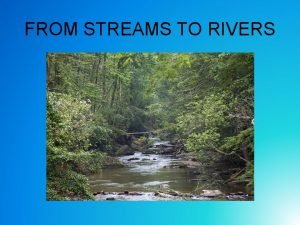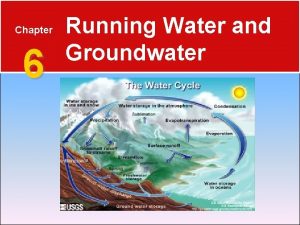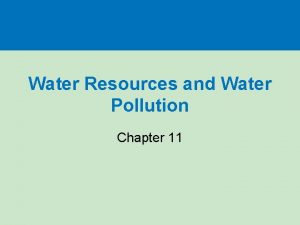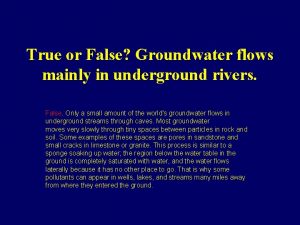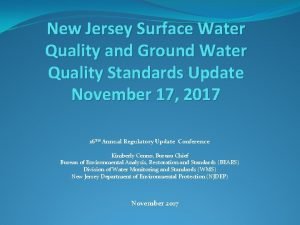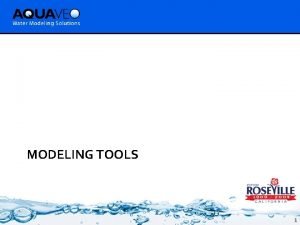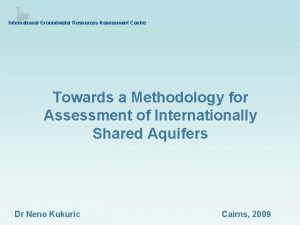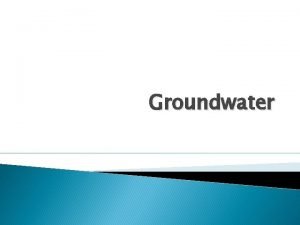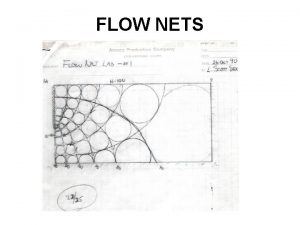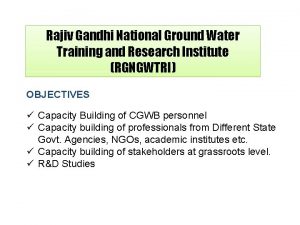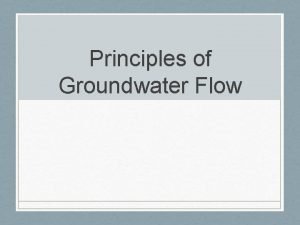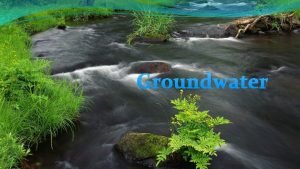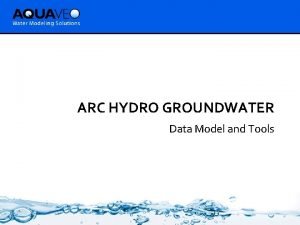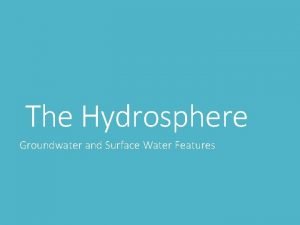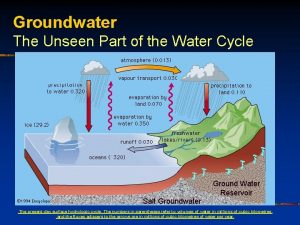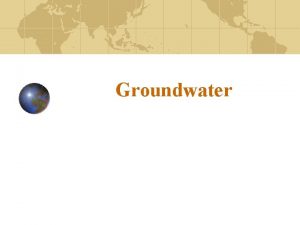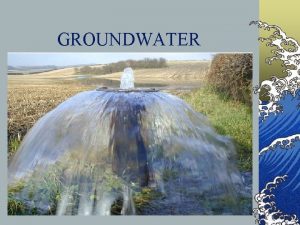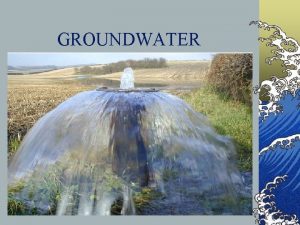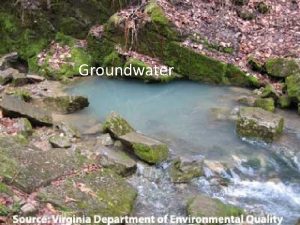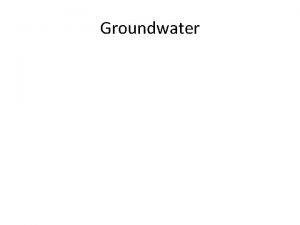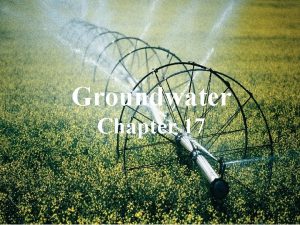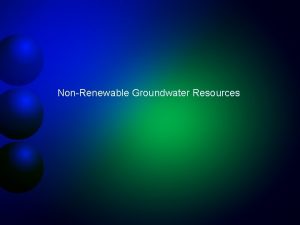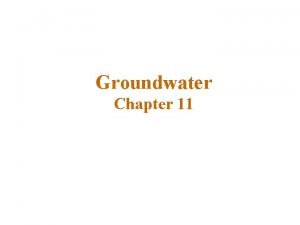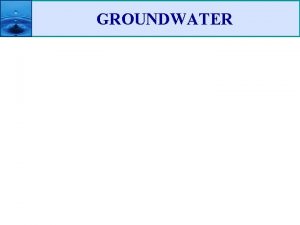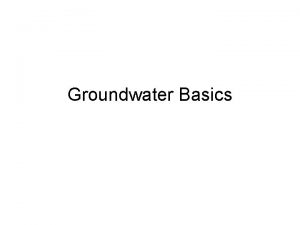Groundwater The Unseen Part of the Water Cycle





















- Slides: 21

Groundwater The Unseen Part of the Water Cycle Ground Water Reservoir Salt Groundwater

Who Uses Groundwater? In Northwest Ohio

Ohio Groundwater Law n 1843: Acton v. Blundell “English Rule” The landowner can pump groundwater at any rate even if an adjoining property owner were harmed. n 1861: Frazier v. Brown English Rule in Ohio Groundwater is “…occult and concealed…” and legislation of its use is “…practically impossible. ”

Wisconsin Groundwater Law 1903: Huber v. Merkel English Rule in Wisconsin n n 1974: Wisconsin v. Michels Pipeline Constructors Inc. English Rule Overturned A property owner can pump unlimited amounts of groundwater, even with malicious harm n Landowners no longer have “an absolute right to use with to a neighbor. impunity all water that can be pumped from the subsoil underneath. ”

English Rule Overturned in Ohio 1984: Cline v. American Aggregates English Rule overturned in Ohio n n Justice Holmes: “Scientific knowledge in the field of hydrology has advanced in the past Today: decade…” so it Lingering effects of English Rule “…can establish the cause and n It is very difficult to prove effect relationship of the tapping of cause and effect to be underground water to the existing defensible in court. water level. ”

Atmosphere 0. 0001% Streams and Lakes 0. 01% (3%) 0. 61% (97%) Most available fresh water is ground water Oceans 97. 2%

Porosity and Permeability n Porosity: Percent of volume that is void space. n n Sediment: Determined by how tightly packed and how 30% clean (silt and clay), (usually between 20 and 40%) Rock: Determined by size and number of fractures (most often very low, <5%) Zone of Aeration Water Table Saturated Zone 5% 1%

Porosity and Permeability n Permeability: Ease with which water will flow through a porous material n Water Table Saturated Zone Sediment: Proportional to sediment size n n n Zone of Aeration Gravel Excellent Sand Good Silt Moderate Clay Poor Rock: Proportional to fracture size and number. Can be good to excellent (even with low porosity) Excellent Poor

Porosity and Permeability Table 13. 1 n Permeability is not proportional to porosity. 30% 5% 1%

The Water Table n n Water table: the surface separating the vadose zone from the saturated zone. Measured using water level in well Fig. 13. 3

The Water Table n Aquifer: Saturated sediment or porous rock that is sufficiently permeable to supply useable amounts of water Fig. 13. 3

Groundwater Systems n Groundwater discharge: n n n Groundwater leaving the subsurface at Natural locations including streams springs and wetlands Artificial means like pumped wells and drains

Groundwater Systems n Infiltration: Precipitation soaking into the soil and moving into the subsurface

Groundwater Systems n Groundwater recharge: Infiltration percolating to the water table

Groundwater Systems n Groundwater Flow: n n n groundwater moves through the small pore spaces from areas with a high water table to areas with a low water table

Groundwater Systems n Velocity is proportional to n n n Permeability Slope of the water table Fast (e. g. , cm per day) Inversely Proportional to n porosity Slow (e. g. , mm per day)

Natural Water Table Fluctuations n Infiltration n n Recharges ground water Raises water table Provides water to springs, streams and wells Reduction of infiltration causes water table to drop

Natural Water Table Fluctuations n Reduction of infiltration causes water table to drop n n Wells go dry Springs go dry Discharge of rivers drops Artificial causes n n Pavement Drainage

Effects of Pumping Wells n Pumping wells n n Accelerates flow near well May reverse groundwater flow Causes water table drawdown Forms a cone of depression

Effects of Pumping Wells n Pumping wells n n Accelerate flow Reverse flow Cause water table drawdown Form cones of depression Gaining Stream Water Table Drawdown Cone of Dry Spring Depression Gaining Stream Low well Low river Pumping well Low well

Effects of Pumping Wells n Continued watertable drawdown n May dry up springs and wells May reverse flow of rivers (and may contaminate aquifer) May dry up rivers and wetlands Dry well Losing Stream Dry well Dry river
 How does groundwater rejoin the water cycle
How does groundwater rejoin the water cycle Water and water and water water
Water and water and water water Running water and groundwater
Running water and groundwater Explain how water erosion by groundwater can form a cave.
Explain how water erosion by groundwater can form a cave. Chapter 6 running water and groundwater
Chapter 6 running water and groundwater Solar radiation has a part in the water cycle by
Solar radiation has a part in the water cycle by Brainpop carbon cycle
Brainpop carbon cycle Water cycle the hydrologic cycle
Water cycle the hydrologic cycle The zone of aeration
The zone of aeration Solution to prevent water pollution
Solution to prevent water pollution True or false: groundwater can flow.
True or false: groundwater can flow. Njdep surface water quality standards
Njdep surface water quality standards Gms groundwater modeling
Gms groundwater modeling Groundwater assessment methodology
Groundwater assessment methodology Water table
Water table Septic tank contamination groundwater
Septic tank contamination groundwater Groundwater flow net
Groundwater flow net Rgngwtri
Rgngwtri Hydrolic head
Hydrolic head Groundwater porosity
Groundwater porosity Arc hydro groundwater
Arc hydro groundwater On the surface of water
On the surface of water
